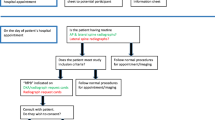Abstract
Purpose
This study sought to assess the usefulness of routine lateral chest radiographs for detecting unrecognised vertebral compression fractures.
Materials and methods
We prospectively selected outpatients without symptoms or risk factors for osteoporosis who underwent chest radiography for different clinical indications. Two independent reviewers with different levels of experience assessed the radiographs for vertebral deformities and graded them as mild, moderate and severe according to the semiquantitative Genant Index. The kappa statistic was used to evaluate interobserver agreement and verify the reproducibility of this method. The prevalence of vertebral fractures observed was compared with that recorded in the official radiology reports.
Results
Our study involved 145 patients (73 men, 72 women; age range 50–86 years, mean age 67.5). Clinically relevant vertebral fractures were seen in 18/145 patients (12.4%). These were moderate in 13 patients and severe in five, and single in 12 patients and multiple in six. Interobserver agreement was very high (κ=0.9). Only 11% of these fractures were recorded in the official reports.
Conclusions
Lateral chest radiographs could be effective for assessing previously unknown vertebral compression fractures in individuals without clinical evidence or risk factors for osteoporosis.
Riassunto
Obiettivo
Verificare l’utilità del radiogramma laterale del torace eseguito per altre indicazioni nella identificazione di fratture vertebrali osteoporotiche non note.
Materiali e metodi
Abbiamo prospetticamente selezionato i pazienti ambulatoriali senza sintomi né fattori di rischio per osteoporosi sottoposti ad esame radiografico del torace per varie indicazioni. Due radiologi con differenti livelli di esperienza hanno separatamente ricercato le anomalie vertebrali presenti in tali pazienti e le hanno classificate in lievi, moderate e severe secondo l’indice semiquantitativo di Genant. Abbiamo usato il k statistico per valutare la variabilità interosservatore e verificare la riproducibilità del metodo. Abbiamo paragonato la prevalenza delle fratture vertebrali osservata con quella delle fratture menzionate nei referti ufficiali.
Risultati
La nostra popolazione risulta composta da 145 pazienti (73 M, 72 F; range di età 50–86 anni, età media 67,5 anni). Diciotto pazienti (18/145=12,4%) presentavano fratture vertebrali clinicamente rilevanti: moderate 13 pazienti, severe 5; fratture singole in 12 pazienti, multiple in 6. La concordanza tra i due esaminatori e stata molto elevata (κ=0,9). Solo l’11% di tali fratture era stata riportata nei referti ufficiali.
Conclusioni
Il radiogramma toracico laterale può rappresentare un vantaggioso sistema per identificare le fratture vertebrali osteoporotiche non note in una popolazione asintomatica e senza fattori di rischio per osteoporosi.
Similar content being viewed by others
References/Bibliografia
Poole KES, Compston JE (2006) Osteoporosis and its management. BMJ 333:1251–1256
Cummings SR, Melton LJ (2002) Epidemiology and outcomes of osteoporotic fractures. Lancet 359:1761–1767
Klotzbuecher CM, Ross PD, Landsman PB et al (2000) Patients with prior fractures have an increased risk of future fractures: a summary of the literature and statistical synthesis. J Bone Miner Res 15:721–739
Kroth PJ, Murray MD, McDonald CJ (2004) Undertreatment of osteoporosis in women, based on detection of vertebral compression fractures on chest radiography. Am J Geriatric Pharmacother 2:112–118
Mui LW, Haramati LB, Alterman DD et al (2003) Evaluation of vertebral fractures on lateral chest radiographs of inner-city post-menopausal women. Calcif Tissue Int 73:550–554
Siris ES, Chen YT, Abbott TA et al (2004) Bone mineral density thresholds for pharmacological intervention to prevent fractures. Arch Intern Med 164:1108–1112
Kanis JA (2002) Diagnosis of osteoporosis and assessment of fracture risk. Lancet 359:1929–1935
World Health Organization Study Group (1984) Assessment of fracture risk and its application to postmenopausal osteoporosis. World Health Organ Teach Ser 843
Wagner S, Stäbler A, Sittek H et al (2005) Diagnosis of osteoporosis: visual assessment on conventional versus digital radiographs. Osteoporos Int 16:1815–1822
Ross PD, Davis JW, Epstein RS et al (1991) Pre-existing fractures and bone mass predict vertebral fracture incidence in women. Ann Intern Med 114:919–923
Ross PD, Genant HK, Davis JW et al (1993) Predicting vertebral fracture incidence from prevalent fractures and bone density among non-black osteoporotic women. Osteoporos Int 3:120–126
National Osteoporosis Foundation (1999) Phyisician’s guide to prevention and treatment of osteoporosis: National Osteoporosis Foundation, Washington, DC
Chassang M, Grimaud A, Cucchi JM et al (2007) Can low-dose computed tomographic scan of the spine replace conventional radiography? An evaluation based on imaging myelomas, bone metastases, and fractures from osteoporosis. Clinical Imaging 31:225–227
Kim N, Rowe BH, Raymond G et al (2004) Underreporting of vertebral fractures on routine chest radiography. AJR Am J Roentgenol 182:297–300
Gelbach SH, Bigelow C, Heimisdottir M et al (2000) Recognition of vertebral fractures in a clinical setting. Osteoporos Int 11:577–582
Majumdar SR, Kim N, Colman I et al (2005) Incidental vertebral fractures discovered with chest radiography in the emergency department: prevalence, recognition and osteoporosis management in a cohort of elderly patients. Arch Intern Med 165:905–909
Genant HK, Wu CY, Van Kuijk C et al (1993) Vertebral fractures assessment using a semiquantitative technique. J Bone Min Res 8:1137–1148
Damilakis J, Maris TG, Karantanas AH (2007) An update on the assessment of osteoporosis using radiologic techniques. Eur Radiol 17:1591–1602
Grados F, Roux C, de Vernejoul MC et al (2001) Comparison of four morphometric definitions and a semiquantitative consensus reading for assessing prevalent vertebral fractures. Osteoporos Int 12:716–722
Morris CA, Carrino JA, Lang P et al (2006) Incidental vertebral fractures on chest radiographs. Recognition, documentation and treatment. J Gen Intern Med 21:352–356
Author information
Authors and Affiliations
Corresponding author
Rights and permissions
About this article
Cite this article
Cataldi, V., Laporta, T., Sverzellati, N. et al. Detection of incidental vertebral fractures on routine lateral chest radiographs. Radiol med 113, 968–977 (2008). https://doi.org/10.1007/s11547-008-0294-1
Received:
Accepted:
Published:
Issue Date:
DOI: https://doi.org/10.1007/s11547-008-0294-1




